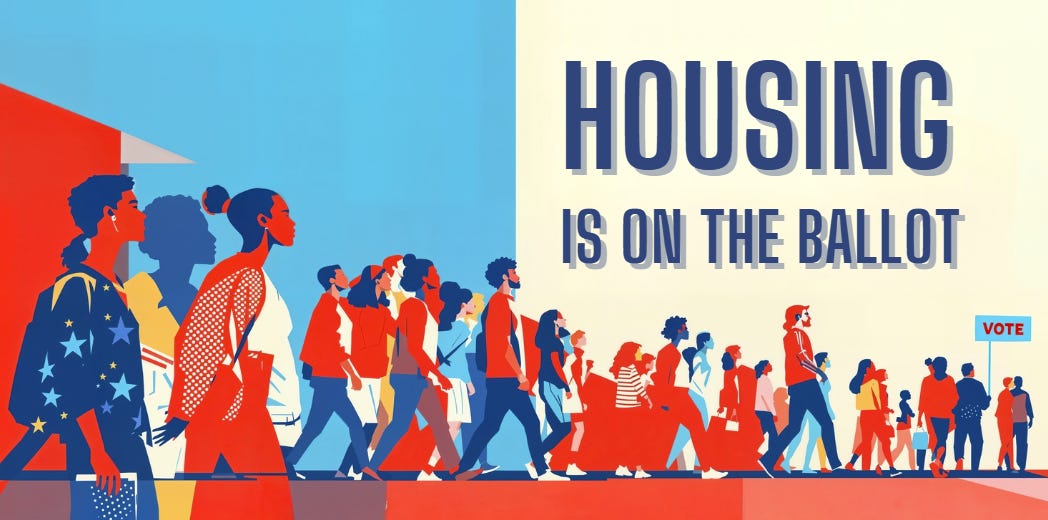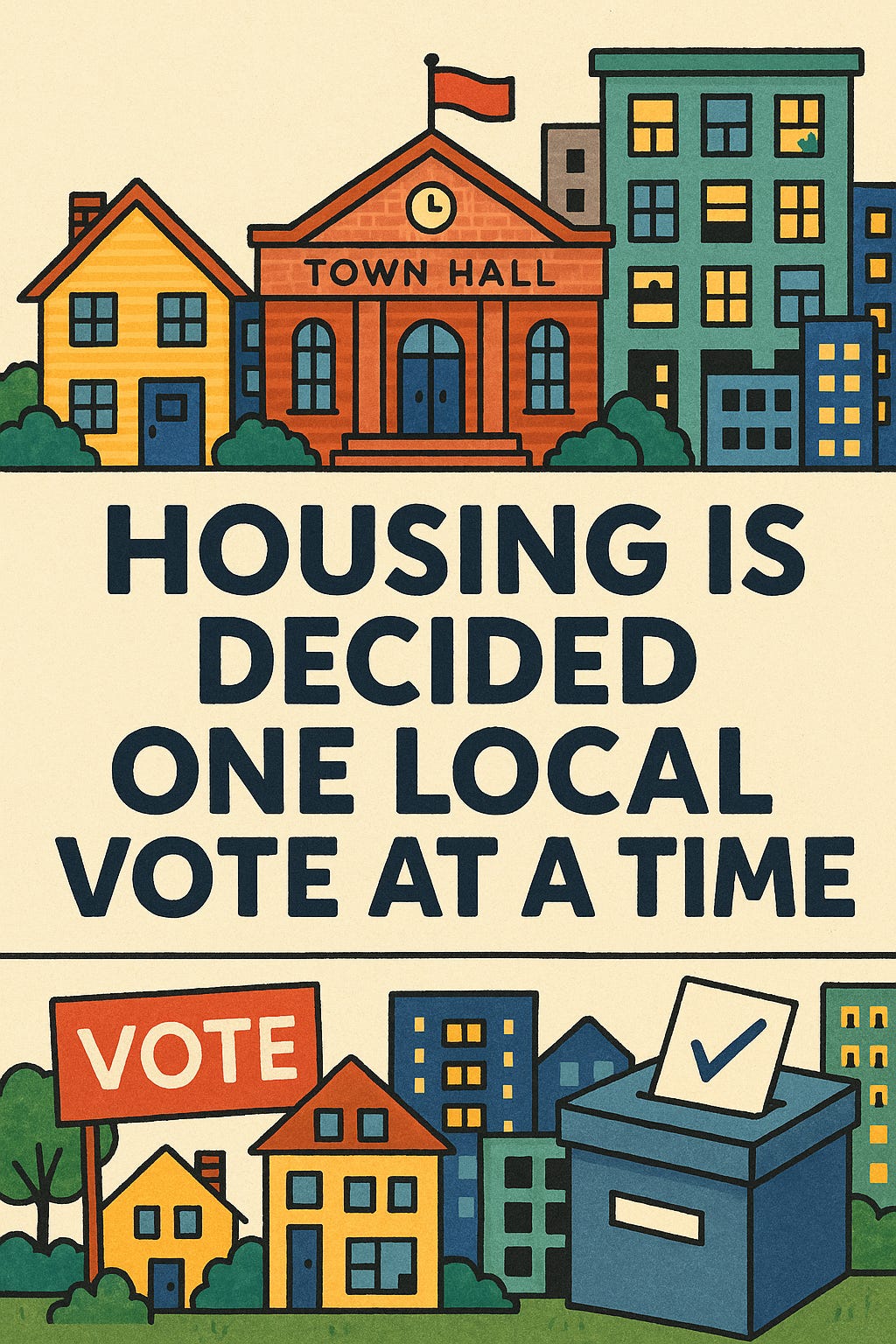Housing Is the One Thing We’re Supposed to Agree On
The national ROAD to Housing Act sets the standard for housing reform. Local elections will decide if we rise to meet it.
Every generation believes its challenges are unique, but America’s housing shortage is both timeless and urgent. It touches nearly every family, in every county and every political district. From the price of a starter home to the scarcity of affordable rentals, the cost of housing now defines our quality of life and our local politics alike.
In the Triangle, that reality feels close to home. Families who have lived here for decades watch their children priced out of the neighborhoods they grew up in. Newcomers arrive ready to work, but struggle to find a place to live. And too many of our cities have allowed the same pattern to continue: long approval processes, outdated zoning, and too little housing of every kind.
Local elections decide how our cities grow. They decide who approves the next housing project, who sets zoning rules, and who says yes or no to new neighbors. Yet we often treat every rezoning like a referendum instead of a responsibility. We argue over the details and forget the bigger picture.
Today, on Election Day, we need to remember what housing is supposed to represent. It’s the one thing we’re supposed to agree on.
VOTE FOR HOUSING TODAY!
Check out our voter guides for Durham and the Triangle.
Find your polling place and tell a friend too.
Polls are open until 7:30pm on Nov 4th.
The ROAD Ahead
But housing policy doesn’t stop at the city line. The choices our councils make connect directly to the policies Congress is debating nationally.
The Renewing Opportunity in the American Dream (ROAD) to Housing Act, introduced by Senators Elizabeth Warren and Tim Scott, passed the Senate in October with overwhelming bipartisan support. The Argument recently featured the bill with praise for Capitol Hill finally taking YIMBY issues seriously thanks to the bipartisan committee’s leadership.
Watch Sen. Warren talk about the Road to Housing Act just before the Senate vote.
Even with the federal government currently shut down, and the ROAD Act sitting in the House, a major milestone has been reached. The bill ties together 27 bipartisan proposals to increase housing supply, modernize zoning, streamline permitting, and invest in affordable housing at every level. It recognizes what most Americans already know: the only way to make housing affordable again is to build more of it, in more places, for more people.
These policies are not theoretical.
They are a call for alignment.
Because if housing decisions made at every level of government helped create today’s shortage, then every level must be part of the solution.
Federal agencies once promoted exclusionary zoning templates that separated neighborhoods by income and race.
States, including our own, have stepped back from funding transit and regional planning, forcing cities to compete rather than cooperate.
Local governments have too often focused on keeping current residents comfortable rather than welcoming their children, working families, and newcomers.
The result is the system we live in today: rising prices, endless process, and too few homes. It will take policy alignment across numerous fronts including federal reform, state leadership, and local courage to change our housing reality.
Abundance through Alignment
This election decides more than just who sits on council. It decides whether our cities will act on the same principles that both parties in Congress already agree on — that building homes is essential to building opportunity.
Some voices still try to frame progress as “giving away the city to developers.” That argument misses the point. Housing is not a giveaway when it meets the needs of the people who already live here and the people who want to.
Building housing is how we share the benefits of growth instead of hoarding them for those already here. The real question isn’t whether we build, but how well we choose to build together.
Every level of government has a role to play, and the ROAD to Housing Act gives us a clear federal framework to align with. These same policy areas apply directly to our cities and counties in the Triangle.
Taken together, they outline the shared values that CITYBUILDER and our members believe in — legalizing homes, funding affordability, protecting tenants, and building communities that work for everyone.
The ROAD Act’s eight major sections mirror the key areas where local governments can act right now. This is what alignment looks like in practice.
1. Legalize More Homes
Federal policy: The ROAD to Housing Act directs the federal government, via HUD, to publish voluntary model frameworks for states and local governments to modernize their land-use and zoning policies. It encourages localities to allow more housing types, remove barriers to small-scale infill, and expand where multi-unit housing can be built.
Local reality: Raleigh, Durham, and Chapel Hill have already ended exclusionary zoning and legalized ADUs, duplexes and other missing middle housing types citywide. Other local towns have more to do.
2. Fix the Process
Federal policy: The Act includes several provisions (such as the BUILD Housing Act and the Unlocking Housing Supply Through Streamlined and Modernized Reviews Act) that streamline environmental review for small-scale and infill housing, allow states and localities to take over parts of the NEPA review process, and reduce administrative delays that slow down housing delivery.
Local reality: While Raleigh and Durham have made some housing easier to build by right in recent years, there are still costly site planning and rezoning requirements that impact the speed and cost at which housing can be created. Local reforms could mirror federal priorities by guaranteeing faster, by-right approvals for compliant projects.
3. Build Near Transit and Jobs
Federal policy: The Build More Housing Near Transit Act ties federal transit funding incentives to local housing reforms, rewarding regions that reduce parking minimums, allow more density near stations, and adopt by-right zoning for homes near major transit corridors.
Local reality: Raleigh has created strong transit overlay districts along Bus Rapid Transit corridors by coupling upzoning with affordability density bonuses. Durham, Chapel Hill and Garner are making plans for BRT and need to make plans for housing too. Regional coordination could, but doesn’t yet, link housing production goals directly to transit funding, matching the spirit of the federal act.
4. Repair and Preserve
Federal policy: The Whole-Home Repairs Act and the PRICE Act in the ROAD package fund essential home repairs and upgrades so that existing housing stays safe and livable. These programs are designed to keep people housed while new housing supply comes online.
Local reality: The majority of our region’s most affordable homes are the ones already standing, yet local repair programs in Durham and Wake County run out of money almost as soon as they open. Maintaining this stock keeps families stable while we build the next generation of housing. Real affordability comes from adding homes and maintaining the ones we have, not from using “preservation” as an excuse to stop growth.
5. Innovate
Federal policy: The Manufactured Housing for America title removes outdated barriers like the federal “permanent chassis” requirement, expands FHA financing options for modular housing, and funds research into a standardized code for off-site construction. These steps modernize federal rules so factory-built housing can compete on equal footing with site-built homes.
Local reality: North Carolina still treats modular and HUD-code homes as second-class. Cities can lead by updating local design standards to integrate modular and manufactured homes into existing neighborhoods.
6. Fund Affordability
Federal policy: The ROAD Act reauthorizes and strengthens several key programs, including the HOME Investment Partnerships and the Low-Income Housing Tax Credit (LIHTC), expands bank investment limits for community development projects, and provides matching grants to local governments that demonstrate measurable increases in housing supply.
Local reality: Durham’s 2019 housing bond and Raleigh’s 2020 bond were important steps, with the housing they produced now open and operational. But neither matches the scale of our regional need. The next step is regional, recurring housing bonds that can leverage both new federal funding streams when they become available and local private partnerships that maximize the production of housing with public dollars.
7. Protect Renters and Prevent Displacement
Federal policy: The Choice in Affordable Housing Act improves voucher portability and landlord participation by eliminating redundant inspections and allowing pre-approval of units. It also enhances fair housing enforcement and gives local agencies tools to expand tenant choice and reduce lease-up times.
Local reality: Durham just expanded their tenant protection ordinance. Raleigh and Durham both have eviction support programs that serve as a last line of defense for renters who often feel the most pressure in our extremely tight housing market. Replicating these programs across the state is needed to support renters and their right to housing, while we also increase the supply of rental housing and expand opportunities for ownership.
8. Be Transparent
Federal policy: The Act’s final titles strengthen oversight and data reporting across all major housing agencies — requiring HUD, FHA, USDA, VA, and Fannie Mae to provide annual testimony to Congress, report on program outcomes, and coordinate interagency data on affordability and homelessness.
Local reality: Raleigh is leading the way on housing production transparency with their Missing Middle dashboard. Durham, Cary, and others should publish better and more frequent reports showing what gets built, where, and for whom. Public data builds trust and accountability, just as transparency at the federal level builds confidence in reform.
Vox did a great job of explaining the stakes of federal help. The benefits of new housing almost always outweigh the costs, yet decisions are often made where those most burdened by high rents have the least voice. The ROAD Act is an effort to rebalance that equation, rewarding cities that plan for growth rather than fear it.
Beyond Election Day
The housing crisis is not just a partisan issue. It runs through both parties. There are Democrats and Republicans who understand that solving it means building more homes and there are voices in both parties who still defend the systems that make housing scarce. The ROAD to Housing Act shows that progress is possible when leaders focus on what unites us instead of who gets credit.
CITYBUILDER will keep exploring each of these policy areas in the months ahead. We will explain what they mean for our towns, our state, and the people who call the Triangle home. Our mission continues all year: to educate, advocate, and build coalitions that make more housing possible.
Whether you care most about affordability, fairness, or the simple freedom to find a home, the path forward is the same — more homes, built responsibly.
Today, go vote for housing.
Every local seat on the ballot shapes how and where we build next.
That’s why we made our voter guides and covered these elections.
Tomorrow, we’ll be ready to work with every newly elected leader on the next best step their town can take to make this shared housing vision real.




